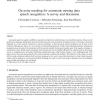125
Voted
CSL
2007
Springer
2007
Springer
Speaker-adaptive learning of resonance targets in a hidden trajectory model of speech coarticulation
15 years 21 days ago
A novel speaker-adaptive learning algorithm is developed and evaluated for a hidden trajectory model of speech coarticulation and reduction. Central to this model is the process o...
124
click to vote
CSL
2007
Springer
15 years 21 days ago
2007
Springer
This paper describes discriminative language modeling for a large vocabulary speech recognition task. We contrast two parameter estimation methods: the perceptron algorithm, and a...
106
Voted
CSL
2007
Springer
15 years 21 days ago
2007
Springer
Determining the position of breaks in a sentence is a key task for a text-to-speech (TTS) system. We describe some methods for phrase break prediction in which the whole sentence ...
114
click to vote
CSL
2007
Springer
15 years 21 days ago
2007
Springer
When users access information from text, they engage in strategic fixation, visually scanning the text to focus on regions of interest. However, because speech is both serial and ...
139
click to vote
CSL
2007
Springer
15 years 21 days ago
2007
Springer
This paper describes the use of dynamic Bayesian networks for the task of articulatory feature recognition. We show that by modeling the dependencies between a set of 6 multi-leve...
95
Voted
CSL
2007
Springer
15 years 21 days ago
2007
Springer
113
Voted
CSL
2007
Springer
15 years 21 days ago
2007
Springer
Automatic speech recognition (ASR) has reached very high levels of performance in controlled situations. However, the performance degrades significantly when environmental noise ...
CSL
2007
Springer
15 years 21 days ago
2007
Springer
In this paper, we propose a neural network model for predicting the durations of syllables. A four layer feedforward neural network trained with backpropagation algorithm is used ...
113
click to vote
CSL
2007
Springer
15 years 21 days ago
2007
Springer
The paper presents the Position Specific Posterior Lattice (PSPL), a novel lossy representation of automatic speech recognition lattices that naturally lends itself to efficient ...
103
Voted
CSL
2007
Springer
15 years 21 days ago
2007
Springer
This experiment assessed the effect of variation in speech rate on comprehension and persuasiveness of a message presented in text-to-speech (TTS) synthesis to native and non-nat...




